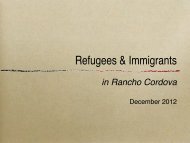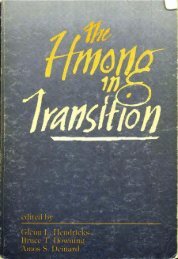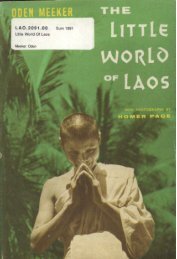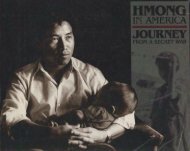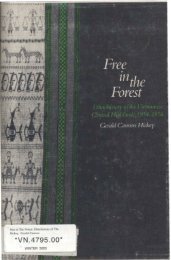PEOPLE
Grant, The Boat People - Refugee Educators' Network
Grant, The Boat People - Refugee Educators' Network
- No tags were found...
You also want an ePaper? Increase the reach of your titles
YUMPU automatically turns print PDFs into web optimized ePapers that Google loves.
The Boat People<br />
transport war arranged for them and some of their possessions. Food<br />
and a small amount of money was provided for the trip. On arrival,<br />
local authorities werc supposed to provide tach family with certain<br />
essentials: land, f m roois, seeds, fertilizers, building materials and<br />
six months' rice. Once in the zones, families were ro buy basic suppl~es<br />
on credit at state-run stores, paying for them after tht fimt harvest.<br />
The NEZS were not simply a way of cutting an intolerably high<br />
level of urban unemployment, boosting agricullural output and<br />
making Vietnam more self-sufficient, They were part of s process<br />
of resmcturing society dong socialist lines. They served to dispmt<br />
people from potential centre1 of dissent and resistance formerly<br />
under the mnaol of the old rkgitne, Once in an NEZ, southtmm<br />
could expect to lx mixed with mlcrs from the north, Northern<br />
adres could shepherd the ideologically unccnain southern flock.<br />
'Re-education', which was intended to reform through 'study,<br />
practice and latar', is as convovcrsial a subject as NEZS. It bepn<br />
on a large ale<br />
in June 1975, when memkrs of the defeated armed<br />
forces were ordered to register. Numbers involved were huge. The<br />
regular force - army, navy, air force and marina - as well as the<br />
regional and popular forces, totalled about 1.2 million men, They<br />
were commanded by 40 000 to 50 000 officers, Paramilitary forces<br />
added another 1.2 million men to the tally; the national police<br />
another 125 000. Many of thest military personnel had shed their<br />
unifum and weapons, donned mufti and merged into civilian life<br />
rather than surrmdcr to the communistsa However, a left-wing<br />
French journalist who w ~s in Saigon after the takeover and had dose<br />
links with the new rulers reported that they had captured one of five<br />
American computers. In its memory bank was a 'Who's Who' that<br />
included informatiori on the politid affiliations of members of the<br />
disbandd army Computer cards for the police and civil service<br />
were also repd<br />
to have bnn recovered. In addition to the military<br />
and police, there were about 300 000 civil servants, politicians, and<br />
others closely associated with the previous rtgimc who were eligible<br />
for reeducation.<br />
lie authorities outlined their approach to the subject in these<br />
terms: Political courses huve been organized to help the persons concerned<br />
to see more clearly the crimes and schemm of the Americans<br />
I<br />
and the traitm, as well as the duties of Viemamere citizens in the<br />
new stage of national reconstruction md socialist itmction, and<br />
to mend their ways in order to find a place for themelvee in the<br />
new society. Thm broad categories of 'the persons concerned' w m<br />
established. In the first were ordinary soldiers, ~ws, and lowranking<br />
mberr of the administration and poiitid organizations<br />
of the previous government. They completed on-the-spot courses in<br />
less than a week. Secondly, there were the more senior funaionarics<br />
and officers, up to the rank of captain. They remained in rp.<br />
education ccnm for anything from ten days to a y w and werc then<br />
liable to sdminisaativr surveillance for dx to twelve month* Then<br />
,<br />
thcrc were the 'difficult' mw from the second categoiy. Thew were<br />
held longer and merged with inmates of camps set up for thosc who<br />
had htld important political, military and policc posts.<br />
Evasiun was consider~ble. In Saigon for cxsmpie, official figures ,<br />
suggest that in one disvict 5000 out of 25 000 military did not regis-<br />
'<br />
ter. Also, although the authorities promised to err on the ~idc of<br />
leniency, so that thmc who were found to have made real ptogrcss ,<br />
would be authorized to return to their homa and to recover their<br />
civil rights earlier than the rtgul~tion time, many detainees hsve ail1<br />
not been released. Most are believed to be military and police officers.<br />
With them are m unknown number of ex-civil servants, politicians<br />
and lml officials. In 1976 Vietnam's ambassador in Paris<br />
claimed 'only 50000' people w m still being htld, In April 1977 a<br />
senior mmunlst official teporttd that 96 per cent of those formerly<br />
associnttd with the defunct Sdgon government had b m<br />
'cnfranchiscd'.<br />
For many, re-cduation was a simple stepping stone to rcinttgration<br />
in society and recovery of civil righu, but for others it was a<br />
tougher transition to probationary or second-class citizenship md<br />
for some (the 'stubhm' cases) it was bleak detention. The US state<br />
department in December 1978 estimated that Vietnam held from<br />
lH3 000 to 200 000 politiaal prisoners. Whatever the actual number,<br />
they are ~pparentiy kept in two types of camp - those for long-term<br />
incarceration and thae from which releases we progressively made.<br />
Most are believed to be in the latter. They live under conditions that<br />
can be survived by people in robust physical health but would certainly<br />
bc damaging if not fatal to the ill and weak, They have to





